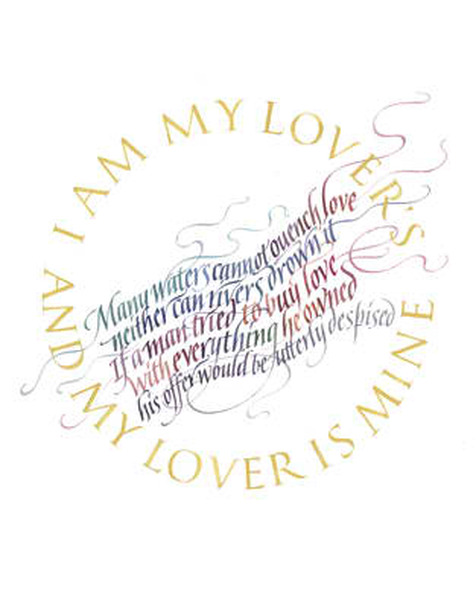The Book of Song of Solomon

The title in the Hebrew text is "the Song of Songs. which is Solomon's," meaning either, for or about Solomon. The phase "Song of Songs" means the greatest of songs. Verse 1 seems to ascribe authorship to Solomon. He is referred to seven times in the book, but whether he was the author remains an open question. Consistency of language, style, tone, perspective and recurring refrains seems to argue for a single author. If Solomon is the author, the Song can be dated in the tenth century B.C. In ancient Israel everything human came to expression in words. In the Song, love finds words-inspired words that disclose its exquisite charm and beauty as one of God's choicest gifts. The woman's voice of love in the Song suggests that love and wisdom draw men powerfully with the subtlety and mystery of a woman's allurements. God intends that such love be a normal part of marital life in His good creation.
The story greatly emphasizes the sanctity of marriage and that it is blessed and consecrated in the eyes of the Lord. The purpose of “Song of Songs”, as it is also called, is a picture of God’s love for His people and although there is explicit sexual content, it is a book in which we can learn the depths of God’s authentic love for us and what should be in the sacredness of marriage.
The story greatly emphasizes the sanctity of marriage and that it is blessed and consecrated in the eyes of the Lord. The purpose of “Song of Songs”, as it is also called, is a picture of God’s love for His people and although there is explicit sexual content, it is a book in which we can learn the depths of God’s authentic love for us and what should be in the sacredness of marriage.

In chapters 1-3, Solomon writes of the courtship and engagement of the Beloved (Solomon) and the Lover (Shulammite girl), “My beloved responded and said to me, ’Arise, my darling, my beautiful one, and come along”(2:10).
Chapters 3-4, we read of the marriage ceremony of the bride to the bridegroom, “Go forth, O daughters of Zion, and gaze on King Solomon with the crown with which his mother has crowned him on the day of his wedding.” (3:11)
Chapters 5-8, are the relationship between the husband and wife and the power of their love, "many waters cannot quench love, nor will rivers overflow it; if a man were to give all the riches of his house for love, it would be utterly despised." (8:7)
Foreshadowing of Jesus
Without a Blemish
Some Bible interpreters see in Song of Solomon an exact symbolic representation of Christ and His church. Christ is seen as the king, while the church is represented by the Shulamite. While we believe the book should be understood literally as a depiction of marriage, there are some elements that foreshadow the Church and her relationship with her king, the Lord Jesus. Song of Solomon 2:4 describes the experience of every believer who is sought and bought by the Lord Jesus. We are in a place of great spiritual wealth and are covered by His love. Verse 16 of chapter
2 says, “My beloved is mine, and I am his. He pastures his flock among
the lilies” (NASB). Here is a picture of not only the security of the believer in Christ (John 10:28-29), but of the Good Shepherd who knows His sheep—believers—and lays down His life for us (John 10:11).
Because of Him, we are no longer stained by sin, having had our “spots” removed by His blood (Song of Solomon 4:7; Ephesians 5:27).
continue to Isaiah...
Chapters 3-4, we read of the marriage ceremony of the bride to the bridegroom, “Go forth, O daughters of Zion, and gaze on King Solomon with the crown with which his mother has crowned him on the day of his wedding.” (3:11)
Chapters 5-8, are the relationship between the husband and wife and the power of their love, "many waters cannot quench love, nor will rivers overflow it; if a man were to give all the riches of his house for love, it would be utterly despised." (8:7)
Foreshadowing of Jesus
Without a Blemish
Some Bible interpreters see in Song of Solomon an exact symbolic representation of Christ and His church. Christ is seen as the king, while the church is represented by the Shulamite. While we believe the book should be understood literally as a depiction of marriage, there are some elements that foreshadow the Church and her relationship with her king, the Lord Jesus. Song of Solomon 2:4 describes the experience of every believer who is sought and bought by the Lord Jesus. We are in a place of great spiritual wealth and are covered by His love. Verse 16 of chapter
2 says, “My beloved is mine, and I am his. He pastures his flock among
the lilies” (NASB). Here is a picture of not only the security of the believer in Christ (John 10:28-29), but of the Good Shepherd who knows His sheep—believers—and lays down His life for us (John 10:11).
Because of Him, we are no longer stained by sin, having had our “spots” removed by His blood (Song of Solomon 4:7; Ephesians 5:27).
continue to Isaiah...
